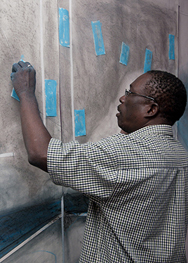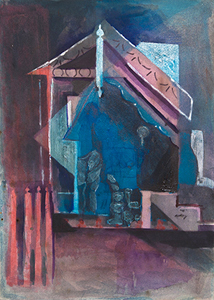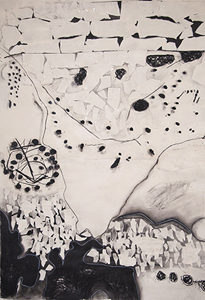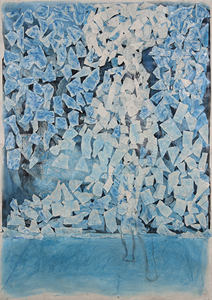
Most artists talk about their personal history with a definitive sense of knowing that they were destined to be an artist.
Not Dudley Charles.
A soft-spoken man with a melodic cadence to his voice, Charles shared with me his story of growing up in Plaisance, Guyana, and the path that placed him on the road to art.
Charles talked about his early years in elementary school, when he was about 10-years-old. He was not a top athlete and, despite his desire to play cricket with his peers, was not sought out to be on their teams. Charles had to fill his school time with another activity, and the only choice available was arts and crafts. The class was comprised primarily of girls. He would look out the window at the boys chasing the ball and be filled with resentment. "I didn't want to play with paints and do drawing," Charles told me. "It was not a cool thing."
Taking out his anger on the paper he was using for his projects, Charles described his behavior as being "like a disobedient kid." Yet, the aggressive markings and interactions with his surface medium would find its way into his technique as an adult.
The parents of Charles raised him to be "a quiet boy," and he internalized those directives. He preferred a solitary and introspective approach to life. Describing the village he grew up in, he outlined the societal strictures. Children were expected to maintain certain standards of behavior -- and the neighbors were always around to keep you in line. "Even now," he told me, "I still feel more at ease by myself."
Both of Charles's parents worked with their hands. His mother was a seamstress, who often showed him her sewing techniques. His father was a carpenter and furniture maker. The family relationship was close.
Charles's father collected his son's drawings and showed them to people in the community. The developing young artist began gaining a reputation. "I didn't want to let my parents down," Charles said, "so I sought out books about art and art history." In his teen years, his father put together a selection of his work. He brought it to a local woman whose sister was a practicing artist. This led to a letter of introduction to Donald Locke, who lived only five miles away.
Charles was unaware of Locke's standing, and the fact that he had studied with E.R. Burrowes, considered by many to be the "Father of Guyanese Art." At the time, Locke was serving as the art master of Queens College in Georgetown, Guyana. Charles packed up his portfolio and took it to Locke for his feedback. "You're very talented," Locke informed Charles. "However," he advised Charles, "talent is not enough. You have to have drive and know what you are going to do with it." Locke lectured Charles about what it meant to be an artist, and a relationship between the two developed and evolved. He was a frequent visitor to the Charles's home. Locke brought his young student into a class that he was leading called Group 67. All the members were considerably older. Among them was Philip Moore.
The cross-dialogue led to fertile ground for exchanging ideas, as well as a progressive space to experiment with subject matter and materials. Charles referred to this time as "his learning period." He articulated, "I would constantly be visiting the library. In Guyana, there weren't that many people or institutions to turn to." By the time he was 18-years-old, Charles was painting full time -- with the financial support of his parents.
In 1970, when Moore left Guyana to become an artist-in-residence at Rutgers and Princeton universities, he recommended Charles for his post at the National History and Art Council. It was a fortuitous opportunity that sustained Charles until 1989. It allowed him time to pursue his own work. As Charles acknowledged, "In life, sometimes things move in a certain way."
Charles discussed his journey to find his authentic voice. He pored over books on European art, trying to connect with potential influences he had an affinity with. He looked at Rembrandt. He looked at Gauguin. Then it struck him. "I'm not those people! Who am I? What is my story?" He remembered narratives that his Grandmother had shared with him -- Guyanese folktales. He recalled legends about spirits that inhabited the big, ornate homes that had belonged to plantation owners.
"I decided to try to tell my story," Charles recounted. He began by looking at the facades of those houses of his grandmother's myths. Many had intricate but crumbling architecture. He let his imagination wander beyond the visible walls, to consider what may have taken place inside of those edifices. The result was a series entitled, Image Old House.

In 1973, Charles was chosen to represent Guyana in the XII Bienal Internacional de Sao Paulo. Four years later, the Guyanese government sent him to Nigeria as part of a delegation of the nation's artists in the World Black and African Festival of Art and Culture known as FESTAC. His work began appearing in group shows from Caracas to New York. He was included in the London exhibit of 1986, Contemporary Caribbean Art. He was part of the 1988 Art for Life exhibit at the Art Museum of the Americas in Washington, D.C. Art historian Samella S. Lewis included him in her book Caribbean Visions: Contemporary Painting and Sculpture.
I questioned Charles about his physical approach to his work, specifically his technique of using his brush to "scrub" the surface of his ground. He uses either canvas or paper. His process involves a series of "mark-making" that is not premeditated. Charles then steps back, sees relationships that have developed, and builds on them. "The work talks to me," he said. "I want each mark to be individualistic."
On a philosophical note he stated, " We're living in the 21st Century, a time when everyone has electronics. I'm creating an illusion of space on a flat surface! I want to tell a story of a time and a place. To have depth. To be timeless. I'm inviting people to come into this space."
Charles referenced Hello Africa, which specifically deals with "space, time, and lines. It is currently being shown at the Skylight Gallery in Brooklyn, New York City in the exhibit, I Kan Do Dat."

Conversing at length about "Blue Venus #5," from his well-known Blue Venus series, Charles is definitive about his blue. It's aquamarine. The shimmering surface has been achieved by rubbing pastel onto heavy, archival paper. Charles used acrylic emulsion paste to collage pieces of paper on the primary surface. A repeated engagement of applying color in different stages ensures that the paper is impregnated with pigment. The result is a three dimensionality from the combined papers, hues, and intensities. The finished piece hangs directly on the wall. "I want the viewer to get lost," Charles explained." I want them pulled into this vast sense of infinity."

Pausing, Charles picks up a different train of thought. "Once you are involved in making art, everything seems secondary. Art is like breathing. Nobody knows the pain and suffering that an artist feels trying to express himself."
Tempering the intensity of his remarks Charles said, "Once people are pulled into my work, I want them to feel joy and happiness -- because when I'm painting I'm happy."
Photos: Jamaal M. Levine
This article is from the series Evolution of an Artist.